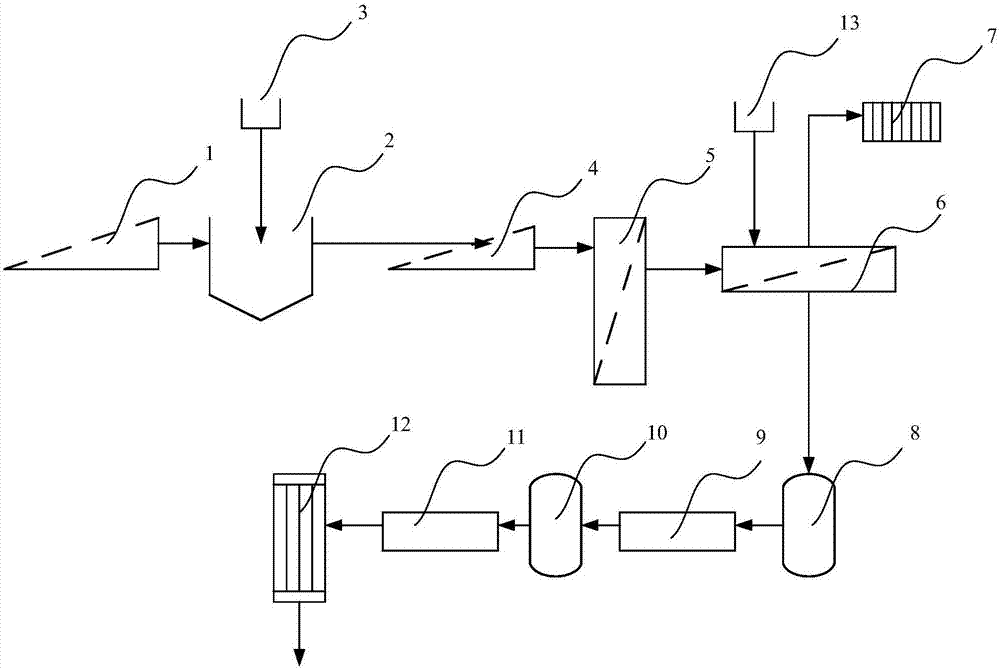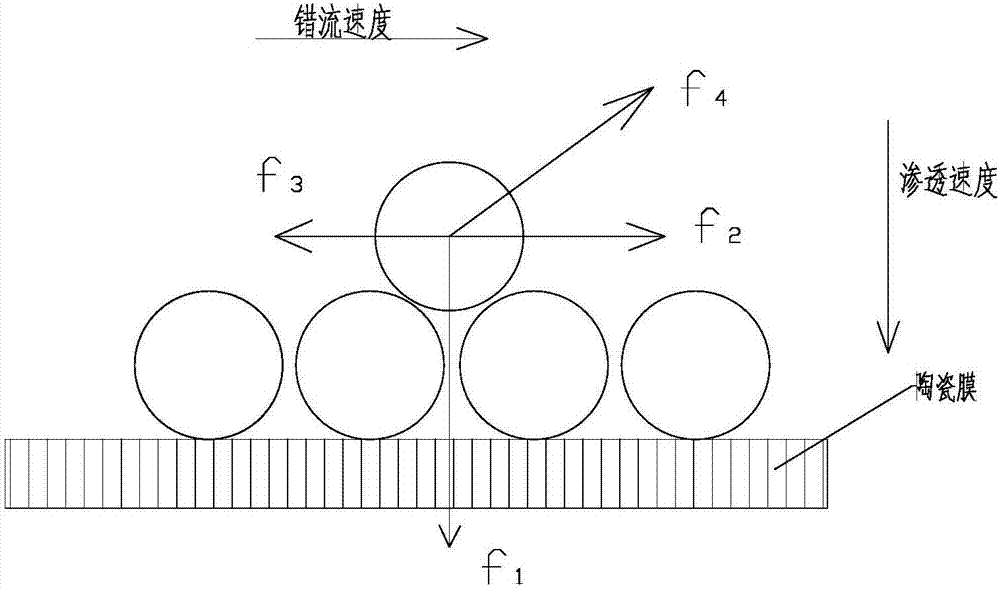Treatment method and device of waste emulsion water
A treatment method and technology of a treatment device, applied in the field of water treatment, can solve problems such as low filtration flux, and achieve the effect of improving filtration flux
- Summary
- Abstract
- Description
- Claims
- Application Information
AI Technical Summary
Problems solved by technology
Method used
Image
Examples
Embodiment 1
[0089] The first step is to carry out inclined plate oil separation treatment on the emulsion wastewater to remove the slick oil;
[0090] In the second step, the waste water obtained in the first step is flocculated. The addition of the flocculant is 0.1wt% of the waste water weight. The flocculant is composed of polyaluminum calcium chloride, ferric chloride, polyacrylamide, citric acid, polymer Ferric chloride and bentonite are mixed, and the weight ratio is 1:0.8:1:0.1:0.1:1;
[0091] In the third step, the wastewater obtained in the second step is subjected to inclined plate sedimentation treatment to remove sediment;
[0092] In the 4th step, the waste water obtained in the 3rd step is filtered by a quartz sand filter to remove impurities of large particles;
[0093] In the 5th step, the waste water obtained in the 4th step is filtered by a tubular ceramic membrane filter, and the structure of the ceramic membrane filter is as follows Figure 5-7 As shown, the average ...
Embodiment 2
[0097] The first step is to carry out inclined plate oil separation treatment on the emulsion wastewater to remove the slick oil;
[0098] In the second step, the wastewater obtained in the first step is flocculated. The amount of flocculant added is 0.1 to 0.5 wt% of the wastewater weight. , Polymerized ferric chloride, bentonite mixed, the weight ratio is 1: 0.9: 2: 2: 0.4: 4;
[0099] In the third step, the wastewater obtained in the second step is subjected to inclined plate sedimentation treatment to remove sediment;
[0100] In the 4th step, the waste water obtained in the 3rd step is filtered by a quartz sand filter to remove impurities of large particles;
[0101] In the 5th step, the waste water obtained in the 4th step is filtered by a tubular ceramic membrane filter, and the structure of the ceramic membrane filter is as follows Figure 5-7 As shown, the average pore size range of the tubular ceramic membrane filter is 500μm, the membrane surface flow velocity dur...
Embodiment 3
[0105] The first step is to carry out inclined plate oil separation treatment on the emulsion wastewater to remove the slick oil;
[0106] In the second step, the wastewater obtained in the first step is flocculated. The amount of flocculant added is 0.1 to 0.5 wt% of the wastewater weight. , Polymerized ferric chloride, bentonite mixed, the weight ratio is 1:0.85:1.5:0.5:0.2:2;
[0107] In the third step, the wastewater obtained in the second step is subjected to inclined plate sedimentation treatment to remove sediment;
[0108] In the 4th step, the waste water obtained in the 3rd step is filtered by a quartz sand filter to remove impurities of large particles;
[0109] In the 5th step, the waste water obtained in the 4th step is filtered by a tubular ceramic membrane filter, and the structure of the ceramic membrane filter is as follows Figure 5-7 As shown, the average pore size range of the tubular ceramic membrane filter is 200 μm, the membrane surface flow rate during...
PUM
| Property | Measurement | Unit |
|---|---|---|
| pore size | aaaaa | aaaaa |
| pore size | aaaaa | aaaaa |
| pore size | aaaaa | aaaaa |
Abstract
Description
Claims
Application Information
 Login to View More
Login to View More - R&D
- Intellectual Property
- Life Sciences
- Materials
- Tech Scout
- Unparalleled Data Quality
- Higher Quality Content
- 60% Fewer Hallucinations
Browse by: Latest US Patents, China's latest patents, Technical Efficacy Thesaurus, Application Domain, Technology Topic, Popular Technical Reports.
© 2025 PatSnap. All rights reserved.Legal|Privacy policy|Modern Slavery Act Transparency Statement|Sitemap|About US| Contact US: help@patsnap.com



